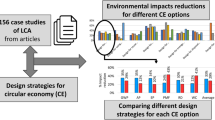Abstract
This work presents a sustainability analysis of CO2 reuse to produce dimethyl carbonate (DMC) via ethylene oxide (ROUTE A) and via urea methanolysis (ROUTE B). Two different technologies are considered in ROUTE A: reaction followed by separation and reactive distillation. Life cycle analyses of the ROUTES are presented employing sustainability analysis performed in HYSYS process simulator, along with WAR Algorithm. Process economical optimization is performed to maximize the processes profitability. A sustainability function, defined as a 2D indicator involving both economical and environmental aspects, is calculated for the optimized processes. Additional sustainability indexes are evaluated: material index, energy index, and ecoefficiency. The results, under both economical and environmental aspects, show that ROUTE A is the most sustainable. The study also points to the relevance of the frontier set between the domains cradle-to-gate and gate-to-gate in assessing process sustainability during LCA.













Similar content being viewed by others
Abbreviations
- K :
-
Arrhenius pre-exp. factor
- E A :
-
Activation energy
- N :
-
Column’s number of trays
- x i,top :
-
Molar fraction of component i in distillate
- x i,bot :
-
Molar fraction of component i in bottoms
- reci,top :
-
Molar fraction of component i recovered in distillate
- reci,bot :
-
Molar fraction of component i recovered in bottoms
- V :
-
Volume (m³)
- SF i :
-
Sustainability function of route i
- P i :
-
Profit of route (US$/year)
- T i :
-
Temperature of stream i (°C)
- EI i :
-
Environmental impact of route i (PEI/y)
- EIm,i :
-
Modified environmental impact of route i (PEI/y)
- ω P :
-
Weight of function P (year/US$)
- ω EI :
-
Weight of function EI (year/PEI)
- ω k :
-
Weighting factor associated to function k
- M CO2,i :
-
Mass of CO2-eq emitted in route i (kg)
- M product,i :
-
Mass product obtained in route i (kg)
- C :
-
Equipment cost (US$)
- Fc :
-
Correction factor
- H :
-
Equipment height (ft)
- D :
-
Equipment diameter (ft)
- M&S:
-
Marshall and Swift index
- A :
-
Heat transfer area (ft²)
- LD50 :
-
Median lethal dose
- M :
-
Material index
- E :
-
Energy index (kJ/kg)
- ε :
-
Ecoefficiency
- p :
-
Products mass flow (kg/h)
- rm:
-
Raw materials mass flow (kg/h)
- e :
-
Energy consumption (kJ/h)
- ec:
-
Economical indicator
- en:
-
Environmental indicator
References
Anastas PT, Allen D (2002) Green chemistry. In: Allen DT, Shonnard DR (eds) Green engineering: environmentally conscious design of chemical processes. Prentice-Hall, New Jersey, pp 177–198
Aubé, F (2001) Guide for computing CO2 emissions related to energy use. CANMET Energy Diversification Research Laboratory. Available at: http://canmetenergy.nrcan.gc.ca
Bezzo F, Barolo M (2005) Understanding the dynamic behaviour of middle-vessel continuous distillation columns. Chem Eng Sci 60:553–563
Bulasara VK, Uppaluri R, Ghoshal AK (2008) Revamp study of crude distillation unit heat exchanger network: energy integration potential of delayed coking unit free hot streams. Appl Therm Eng (in press). doi:10.1016/j.applthermaleng.2008.11.013
Cabezas H, Bar JC, Mallik SK (1999) Pollution prevention with chemical process simulators: the generalized waste reduction (WAR) algorithm—full version. Comput Chem Eng 23:623–634
Cetesb (2009) http://www.cetesb.sp.gov.br/arquivos_default/100co2.pdf
Cui H, Wang T, Wang F, Gu C, Wang P, Dai Y (2004) Kinetic study on the one-pot synthesis of dimethyl carbonate in supercritical CO2 conditions. Ind Eng Chem Res 43:7732–7739
Douglas JM (1988) Conceptual design of chemical processes. McGraw-Hill, New York
Environmental Protection Authority of Australia (2002) http://www.epa.wa.gov.au/docs/1522_B1075.pdf
Fang Y-J, Xiao W-D (2004) Experimental and modeling studies on homogeneous reactive distillation system for dimethyl carbonate synthesis by transesterification. Sep Purif Technol 34:255–263
Hossain KA, Khan FI, e hawboldt K (2007) E-Green–a robust risk-based environmental assessment tool for process industries. Ind Eng Chem Res 46:8787–8795
Knapp JP, Doherty MF (1990) Thermal integration of homogeneous azeotropic distillation sequences. AIChE J 36(7):969–984
Marteel AE, Davies JA, Olson WW, Abraham MA (2003) Green chemistry and engineering: drivers, metrics, and reduction to practice. Annu Rev Environ Resour 28:401–428
Martins AA, Mata TM, Costa CAV (2007) Sikdar SK Framework for sustainability metrics. Ind Eng Chem Res 46:2962–2973
Monteiro JGM-S, Araújo OQF, Medeiros JL (2008) Sustainability metrics for ecotechnologies assessment, part I: preliminary screening. Clean Techn Environ Policy (in press). doi: 10.1007/s10098-008-0189-9
Thotla S, Mahajani SM (2009) Conceptual design of reactive distillation for selectivity improvement in multiple reactant systems. Chem Eng Res Des 87:61–82
Wang HW, Huang ZH, Zhou LB, Jiang DM, Yang ZL (2000) Investigation on emission characteristics of a compression ignition engine with oxygenated fuels and exhaust gas recirculation. J Automob Eng 214(5):503–508
Wang F, Zhao N, Li J, Zhao W, Xiao F, Wei W, Sun Y (2007) Modeling of the catalytic distillation process for the synthesis of dimethyl carbonate by urea methanolysis method. Ind Eng Chem Res 46:8972–8979
Werder M, Steinfeld A (2000) Life cycle assessment of the conventional and solar thermal production of zinc and synthesis gas. Energy 25:395–409
Van baal H, Lemmen W. The advantages of a large capacity single line urea plant. Stamicarbon bv Technical Report. Available at http://www.stamicarbon.com/publi_presen/brochures/_en/index.htm
Young D, Scharp R, Cabezas H (2000) The waste reduction (WAR) algorithm: environmental impacts, energy consumption, and engineering economics. Waste Manag 20:605–615
Zevenhoven R, Eloneva S, Teir S (2006) Chemical fixation of CO2 in carbonates: routes to valuable products and long-term storage. Catal Today 115:73–79
Author information
Authors and Affiliations
Corresponding author
Rights and permissions
About this article
Cite this article
Monteiro, J.G.MS., de Queiroz Fernandes Araújo, O. & de Medeiros, J.L. Sustainability metrics for eco-technologies assessment, Part II. Life cycle analysis. Clean Techn Environ Policy 11, 459–472 (2009). https://doi.org/10.1007/s10098-009-0205-8
Received:
Accepted:
Published:
Issue Date:
DOI: https://doi.org/10.1007/s10098-009-0205-8




